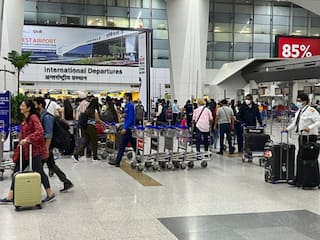Russia storms Mariupol plant as some evacuees reach safety
Zaporizhzhia (Ukraine), May 4 (AP): Russian forces have begun storming the steel mill containing the last pocket of resistance in Mariupol, Ukrainian defenders said, just as scores of civilians evacuated from the bombed-out plant reached relative safety and told of days and nights filled with dread and despair from constant shellin.

Zaporizhzhia (Ukraine), May 4 (AP): Russian forces have begun storming the steel mill containing the last pocket of resistance in Mariupol, Ukrainian defenders said, just as scores of civilians evacuated from the bombed-out plant reached relative safety and told of days and nights filled with dread and despair from constant shelling.
Osnat Lubrani, the UN humanitarian coordinator for Ukraine, said on Tuesday that thanks to the evacuation effort over the weekend, 101 people — including women, the elderly, and 17 children, the youngest 6 months old — were able to emerge from the bunkers under the Azovstal steelworks and "see the daylight after two months." One evacuee said she went to sleep at the plant every night afraid she wouldn't wake up.
"You can't imagine how scary it is when you sit in the shelter, in a wet and damp basement which is bouncing, shaking," 54-year-old Elina Tsybulchenko said upon arriving in the Ukrainian-controlled city of Zaporizhzhia, about 140 miles (230 kilometers) northwest of Mariupol, in a convoy of buses and ambulances.
She added: "We were praying to God that missiles fly over our shelter, because if it hit the shelter, all of us would be done." Evacuees, a few of whom were in tears, made their way from the buses into a tent offering some of the comforts long denied them during their weeks underground, including hot food, diapers and connections to the outside world. Mothers fed small children. Some of the evacuees browsed racks of donated clothing, including new underwear.
The news for those left behind was more grim. Ukrainian commanders said Russian forces backed by tanks began storming the sprawling plant, which includes a maze of tunnels and bunkers spread out over 11 square kilometers (4 square miles).
How many Ukrainian fighters were holed up inside was unclear, but the Russians put the number at about 2,000 in recent weeks, and 500 were reported to be wounded. A few hundred civilians also remained there, Ukrainian Deputy Prime Minister Iryna Vereshchuk said.
"We'll do everything that's possible to repel the assault, but we're calling for urgent measures to evacuate the civilians that remain inside the plant and to bring them out safely," Sviatoslav Palamar, deputy commander of Ukraine's Azov Regiment, said on the messaging app Telegram.
He added that throughout the night, the plant was hit with naval artillery fire and airstrikes. Two civilian women were killed and 10 civilians wounded, he said.
The UN's Lubrani expressed hope for further evacuations but said none had been worked out.
In other battlefield developments, Russian troops shelled a chemical plant in the eastern city of Avdiivka, killing at least 10 people, Donetsk regional governor Pavlo Kyrylenko said.
"The Russians knew exactly where to aim — the workers just finished their shift and were waiting for a bus at a bus stop to take them home," Kyrylenko wrote in a Telegram post. "Another cynical crime by Russians on our land." Explosions were also heard in Lviv, in western Ukraine, near the Polish border. The strikes damaged three power substations, knocking out electricity in parts of the city and disrupting the water supply, and wounded two people, the mayor said. Lviv has been a gateway for NATO-supplied weapons and a haven for those fleeing the fighting in the east.
A rocket also struck an infrastructure facility in a mountainous area in Transcarpathia, a region in far western Ukraine that borders Poland, Hungary, Romania and Slovakia, authorities said. There was no immediate word of any casualties.
Russian Defence Ministry spokesman Maj. Gen. Igor Konashenkov said Russian aircraft and artillery hit hundreds of targets in the past day, including troop strongholds, command posts, artillery positions, fuel and ammunition depots and radar equipment.
Ukrainian authorities said the Russians also attacked at least a half-dozen railroad stations around the country.
The assault on the Azovstal steelworks began almost two weeks after Russian President Vladimir Putin ordered his military not to storm the plant to finish off the defenders but to seal it off. The first — and so far only — civilians to be evacuated from the shattered plant got out during a brief ceasefire in an operation overseen by the UN and the Red Cross.
At a reception centre in Zaporizhzhia, stretchers and wheelchairs were lined up, and children's shoes and toys awaited the convoy. Medical and psychological teams were on standby.
Some of the elderly evacuees appeared exhausted as they arrived. Some of the younger people, especially mothers comforting babies and other young children, appeared relieved.
"I'm very glad to be on Ukrainian soil," said a woman who gave only her first name, Anna, and arrived with two children, ages 1 and 9. "We thought we wouldn't get out of there, frankly speaking." In addition to the 101 people evacuated from the steelworks, 58 joined the convoy in a town on the outskirts of Mariupol, Lubrani said. About 30 people who left the plant decided to stay behind in Mariupol to try to find out whether their loved ones were alive, Lubrani said. A total of 127 evacuees arrived in Zaporizhzhia, she said.
Mariupol has come to symbolise the human misery inflicted by the war. The Russians' two-month siege of the strategic southern port has trapped civilians with little or no food, water, medicine or heat, as Moscow's forces pounded the city into rubble. The plant in particular has transfixed the outside world. (AP) DIV DIV
(This story is published as part of the auto-generated syndicate wire feed. No editing has been done in the headline or the body by ABP Live.)
Trending News
Top Headlines








































